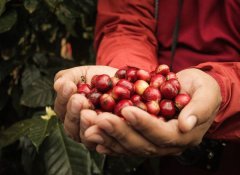The principle of steaming? what is steaming?
About the steaming of coffee. Many baristas or enthusiasts have different opinions on the way, time and amount of steaming, and learn the process of steaming from the physics of steaming in coffee making. When the coffee bean is ground into a coffee powder, the coffee powder we can see with the naked eye is a whole, but in fact, the microstructure of the coffee powder is actually similar to that of a honeycomb, with countless penetrating holes in it. Carbon dioxide is constantly released from freshly roasted coffee beans, and much of this carbon dioxide is initially stored in these holes in the coffee beans.
Just imagine, hot water is poured directly and at high speed on such a coffee powder, the hot water will be extracted close to the periphery of the coffee powder, and the internal carbon dioxide is blocked by water and cannot be eliminated. And because there is carbon dioxide in the powder, the hot water can not seep into the coffee powder. So hot water will only constantly wash the surface of the coffee powder, resulting in excessive extraction on the surface of the coffee powder, but not on the inside.
So the purpose of steaming in coffee is to help coffee powder discharge carbon dioxide smoothly. In order to achieve this goal, the amount of water needed must be the right amount, and gently let the water stop on the coffee powder and let it squeeze into the coffee powder to force the discharge of carbon dioxide to ensure the smooth extraction. For hand flushing with this production method, the amount of steaming water is the best to master. The amount of steaming water is just enough to soak the powder layer until the lower edge of the powder layer begins to drip. But at this point, there are high requirements for the way of water injection, which requires that water injection must be gentle, stable and fast, and it is best that the surface of the foggy powder layer does not blister. Because if blisters, it means that the local high water injection leads to the flow directly through the powder layer flow, and the powder particles are not evenly immersed in water.
At this point, the coffee powder layer has been fully soaked, and water begins to seep into the coffee powder to squeeze out the carbon dioxide. We can obviously see that the powder layer begins to swell and the carbon dioxide is constantly discharged, but if when is the best time to inject water again, it is the moment when all the carbon dioxide is discharged and the coffee powder layer begins to collapse. But it really needs to be observed very carefully when it collapses, but if you can't observe it for the time being, we suggest that the newer the coffee beans, the longer the steaming time. For example, the steaming time of roasting overnight is even 45-50sec, the coffee beans can be reduced to 30-35sec after three days, and the steaming time of coffee beans after a week is probably only 20sec. If the coffee beans for a long time can not be bulged after water injection, it is recommended to cancel steaming and direct secondary water injection.
Similarly, for the equipment such as pressure kettle, electric drip filter, love pressure and so on, we also hope that the relatively new coffee beans can be extracted more efficiently by adding steaming process, and the amount and time of steaming can be properly referred to by hand, but the amount of steaming water under pressure should be reduced appropriately.
Important Notice :
前街咖啡 FrontStreet Coffee has moved to new addredd:
FrontStreet Coffee Address: 315,Donghua East Road,GuangZhou
Tel:020 38364473
- Prev
The principle of steaming? what is steaming?
About the steaming of coffee. Many baristas or enthusiasts have different opinions on the way, time and amount of steaming, and learn the process of steaming from the physics of steaming in coffee making. When the coffee bean is ground into a coffee powder, the coffee powder we can see with the naked eye is a whole one, but in fact, the microstructure of the coffee powder is similar to that of a honeycomb.
- Next

Sun-treated fine coffee
Coffee beans are processed in the following ways: sun (Natural); semi-sun (Semi-Natural or Pulped-Natural); honey processing (Honey processing) and washing (Washing). Water washing treatment means that immature and immature coffee fruits are screened out in a special way after harvesting.
Related
- Beginners will see the "Coffee pull flower" guide!
- What is the difference between ice blog purified milk and ordinary milk coffee?
- Why is the Philippines the largest producer of crops in Liberia?
- For coffee extraction, should the fine powder be retained?
- How does extracted espresso fill pressed powder? How much strength does it take to press the powder?
- How to make jasmine cold extract coffee? Is the jasmine + latte good?
- Will this little toy really make the coffee taste better? How does Lily Drip affect coffee extraction?
- Will the action of slapping the filter cup also affect coffee extraction?
- What's the difference between powder-to-water ratio and powder-to-liquid ratio?
- What is the Ethiopian local species? What does it have to do with Heirloom native species?

